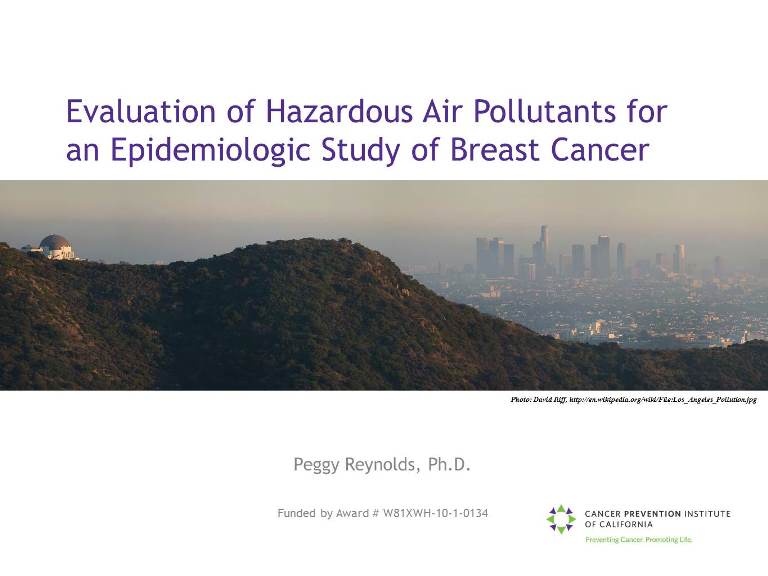Breast Cancer
Hazardous Air Pollutants and Breast Cancer: An Unexplored Area of Risk



Posted June 20, 2016
Peggy Reynolds, M.P.H., Ph.D., Cancer Prevention Institute of California
 Breast cancer incidence rates vary dramatically by geographic region, suggesting that exposure to environmental factors, such as urban air pollution, could play a role in the etiology of breast cancer. Numerous chemicals found in air pollution have been shown to increase mammary gland tumor development in mice or to act as estrogen disruptors, but few studies have explored this risk in human populations. With support from an FY09 Idea Award funded by the Breast Cancer Research Program and the Breast Cancer Research Semipostal, Dr. Peggy Reynolds examined the association of breast cancer and residential exposure to a variety of hazardous air pollutants (HAPs), including potential carcinogens and estrogen disruptors.
Breast cancer incidence rates vary dramatically by geographic region, suggesting that exposure to environmental factors, such as urban air pollution, could play a role in the etiology of breast cancer. Numerous chemicals found in air pollution have been shown to increase mammary gland tumor development in mice or to act as estrogen disruptors, but few studies have explored this risk in human populations. With support from an FY09 Idea Award funded by the Breast Cancer Research Program and the Breast Cancer Research Semipostal, Dr. Peggy Reynolds examined the association of breast cancer and residential exposure to a variety of hazardous air pollutants (HAPs), including potential carcinogens and estrogen disruptors.
In this study, Dr. Reynolds assessed the relationship between breast cancer incidence rates in a prospective cohort of over 112,000 women living in California and estimated outdoor concentrations of HAPs on a census tract level, as modeled by the United States Environmental Protection Agency. This study was unique in that it was the first to examine quantitatively the relationship between ambient exposure to potential mammary gland carcinogens or estrogen disruptors and breast cancer incidence on the individual level. Among the potentially carcinogenic HAPs, a statistically significant increase in breast cancer risk was observed for women residing in areas with high estimated concentrations of propylene oxide and vinyl chloride. Additional HAPs were associated with increased incidence of breast cancer based on the hormone responsiveness of the patient's tumor. Estrogen receptor-positive or progesterone receptor-positive (ER+/PR+) tumors were associated with higher ambient levels of acrylamide, benzidine, carbon tetrachloride, ethylidene dichloride, and vinyl chloride, while ER-/PR- tumors were associated with higher ambient levels of benzene. Among the estrogen-disrupting HAPs, higher levels of cadmium and inorganic arsenic were associated with ER-/PR- tumors in residentially stable non-smoking women.
Findings from this study suggest that environmental exposure to a variety of air pollutants could contribute to an increased risk of breast cancer in some women. This work represents an important foundation for more environmental research to evaluate further the risk associated with HAPs and their potential interplay with tumor hormone signaling.

References:
Garcia E, Hurley S, Nelson DO, Hertz A, Reynolds P. "Evaluation of the agreement between modeled and monitored ambient hazardous air pollutants in California," Intl J Environ Health Research, 2014 Aug;24(4):363-77
Garcia E, Hurley S, Nelson DO, Hertz A, Reynolds P. "Hazardous air pollutants and breast cancer risk in California teachers: a cohort study." Environmental Health 2015 January; 14:14
Liu R, Nelson DO, Hurley S, Hertz A, Reynolds P. "Residential exposure to estrogen disrupting hazardous air pollutants and breast cancer risk: the California Teachers Study," Epidemiology, 2015 May;26(3):365-73
Last updated Thursday, December 5, 2024














